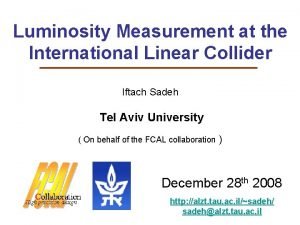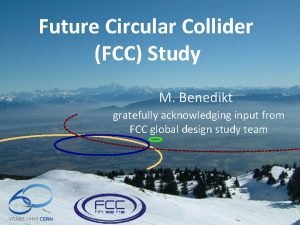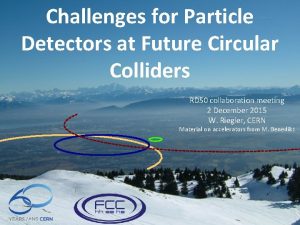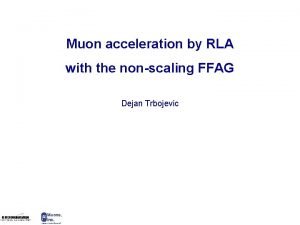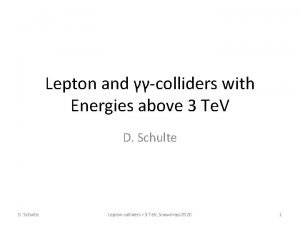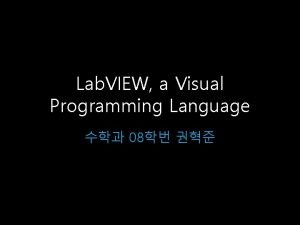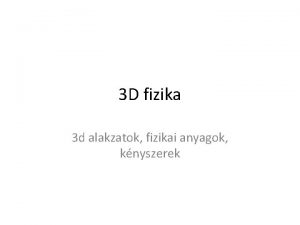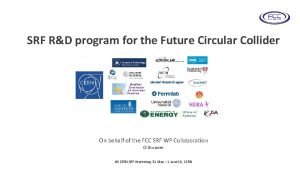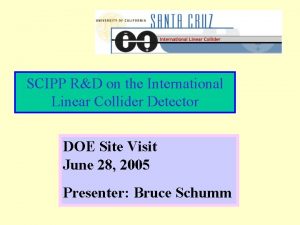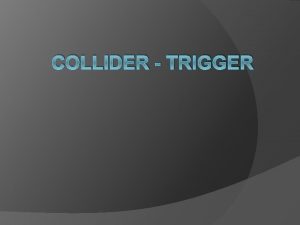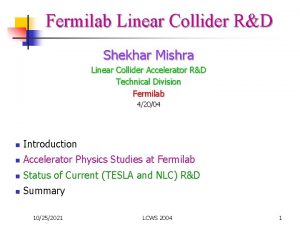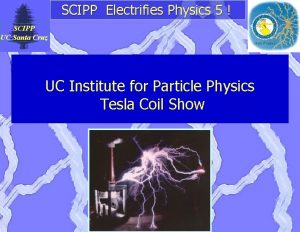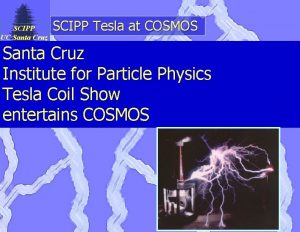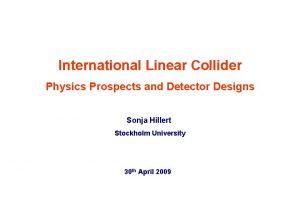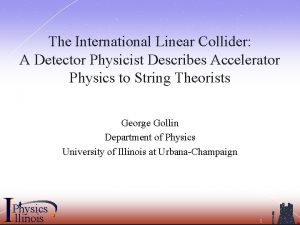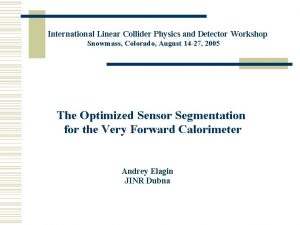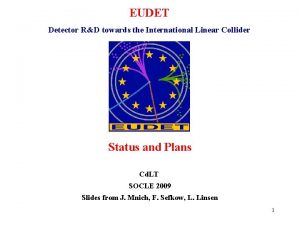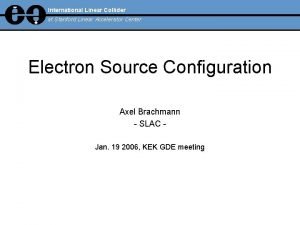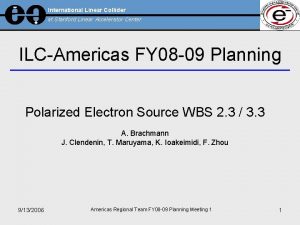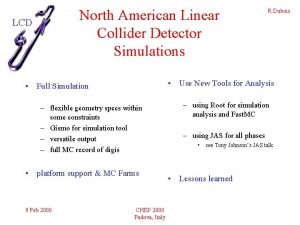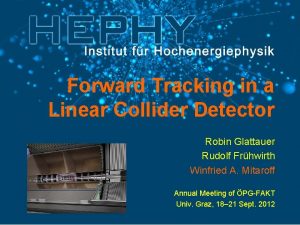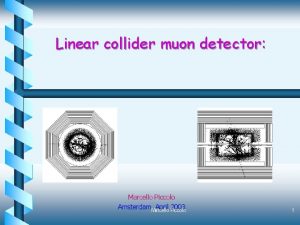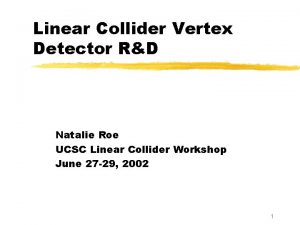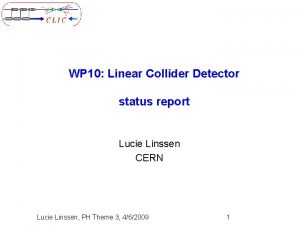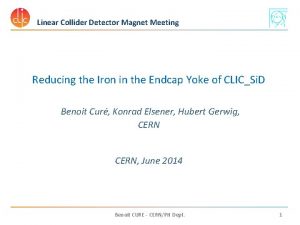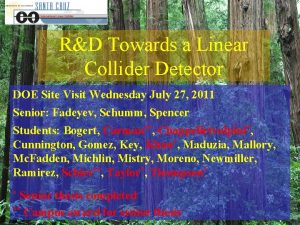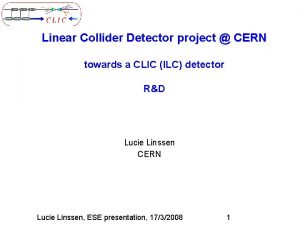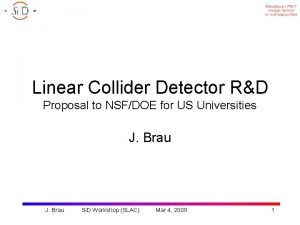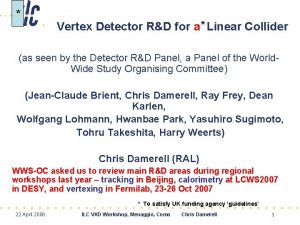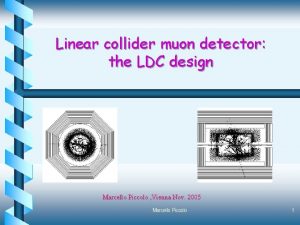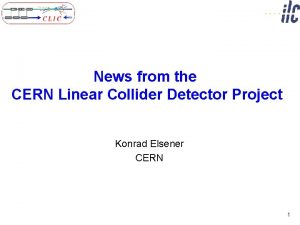SCIPP RD on the International Linear Collider Detector


















![The SCIPP/UCSC ILC HARDWARE GROUP Faculty/Senior Post-Docs Alex Grillo [Gavin Nesom*] Hartmut Sadrozinski Jurgen The SCIPP/UCSC ILC HARDWARE GROUP Faculty/Senior Post-Docs Alex Grillo [Gavin Nesom*] Hartmut Sadrozinski Jurgen](https://slidetodoc.com/presentation_image_h2/b9c1d3a57baab44c5f0badae75876e6b/image-19.jpg)










- Slides: 29

SCIPP R&D on the International Linear Collider Detector SCIPP Review May 18, 2006 Presenter: Bruce Schumm

R&D Activity is increasing, with studies now on four fronts: Ø Physics and machine studies for e-e- running Ø Detector resolution standards from physics simulation Ø Reconstruction capabilities of all-silicon tracking Ø Hardware proof-of-principle of low-noise silicon strip readout Current involvements (all very much part time) 3 senior physicists, 1 post-doc (looking for a second), 8 (current) undergraduate students, 1 engineer, 2 technical staff, one bored spouse of a Silicon Valley engineer.

International Linear Collider: Activity on the e-e- Front Clem Heusch is the SCIPP participant in e-e- studies • Leading international effort in the use and application of e-e- beams at the ILC • Continuing series of workshops hosted by SCIPP; proceedings published in World Scientific • Heusch is a member of ILC Subcommittee on International Collaboration.

Detector Resolution Standards from Selectron Production Participants: Senior Physicist Bruce Schumm Undergraduate Thesis Students Sharon Gerbode, Heath Holguin, Troy Lau*, Paul Moser, Adam Perlstein, Joseph Rose, Matthew Vegas Community Member (on hold before Grad School) Ayelet Lorberbaum *Recipient of two Undergraduate Research Awards; grad school at U. Michigan.

Motivation To explore the effects of limited detector resolution on our ability to measure SUSY parameters in the forward region (“benchmark process” study). Si. D Tracker

Determine the selectron mass accuracy in both the central (0 < |cos | <. 8) and full (0 < |cos | < 1) region


Simulation of Si. D Tracking System (and Si. D variants) Participants: Senior Physicist Bruce Schumm Recent Graduate Students Christian Flacco, Michael Young* Undergraduate Students John Mikelich, Tyler Rice, Lori Stevens, Eric Wallace *Supported primarily through department (TA) funds; SLAC paid for ½ of his support this summer.

Simulation of Si. D Tracking System, continued Three areas of work: Fast MC Simulation Billior-based LCDTRK. f (B. Schumm) provides covariance matrices for fast MC simulation and resolution plots. Si. D Tracking Capabilities Explore tracking performance of Si. D tracker and variants Microstrip Pulse Development Simulation Provides simulation of pulse development and amplification for designing and detector layout

LCDTRK. f comparison of Si. D options with TESLA (LDC) design, from Snowmass 2005

CURVATURE ERROR vs. CURVATURE Standard (Original) Code

Pattern Recognition Capabilities of an All. Silicon Central Tracker Si. D Tracker Can one do pattern recognition with only five central tracking layers? Might more layers improve performance to an extent that justifies the extra material? Current code: Nick Sinev, U. Oregon

EFFICIENCIES FOR QQBAR EVENTS Doesn’t look that spectacular; what might be going on here?

Of course! The requirement of a VXD stub means that you miss anything that originates beyond r ~ 3 cm. This is about 5% of all tracks. With current “VXDBased. Reco” algorithm, we won’t get the ~5% of tracks that originate beyond 2 cm.

Outside-in Tracking (Eric Wallace) Circle-fit tracker (Tim Nelson, SLAC) developed at Snowmass Eric has optimized this algorithm for finding non-prompt tracks after hits from VXDBased. Reco tracks are flagged Remaining tracks found with ~80% efficiency All remaining tracks Found Not found Radial Origin (mm) Essential tool for Si. D tracker optimization.

Pulse Development Simulation Long Shaping-Time Limit: strip sees signal if and only if hole is col-lected onto strip (no electrostatic coupling to neighboring strips) Include: Landau deposition (SSSim. Side; Gerry Lynch LBNL), variable geometry, Lorentz angle, carrier diffusion, electronic noise and digitization effects

Result: S/N for 167 cm Ladder

Electronics Simulation Detector Noise: From SPICE simulation, normalized to bench tests with GLAST electronics Analog Measurement: Employs time-overthreshold with variable clock speed; lookup table provides conversions back into analog pulse height (as for actual data) Essential tool for design of front-end ASIC RMS Gaussian Fit Detector Resolution (units of 10 m)
![The SCIPPUCSC ILC HARDWARE GROUP FacultySenior PostDocs Alex Grillo Gavin Nesom Hartmut Sadrozinski Jurgen The SCIPP/UCSC ILC HARDWARE GROUP Faculty/Senior Post-Docs Alex Grillo [Gavin Nesom*] Hartmut Sadrozinski Jurgen](https://slidetodoc.com/presentation_image_h2/b9c1d3a57baab44c5f0badae75876e6b/image-19.jpg)
The SCIPP/UCSC ILC HARDWARE GROUP Faculty/Senior Post-Docs Alex Grillo [Gavin Nesom*] Hartmut Sadrozinski Jurgen Bruce Schumm Kroseberg Abe Seiden Students Greg Horn Glenn Gray Bryan Matsuo (Comp. Sci. ) Lead Engineer: Ned Spencer Technical Staff: Max Wilder, Forest Martinez-Mc. Kinney *Recently lured away by the sirens of Silicon Valley

The LSTFE-2 ASIC Process: TSMC 0. 25 m CMOS 3 s shaping time; analog readout it Time-Over-Threshold with 400 nsec clock

128 mip 1 mip Operating point threshold 1/4 mip Readout threshold

INITIAL RESULTS LSTFE-2 chip mounted on readout board FPGA-based control and dataacquisition system

Comparator S Curves 0. 46 f. C 0. 80 f. C 1. 11 f. C 1. 42 f. C Vary threshold for given in put charge Read out system with FPGA Get 1 -erf(threshold) with 50% point given response, and width giving noise 1. 73 f. C 2. 04 f. C

Gain and Noise Results (Load = 150 p. F, or about a 115 cm detector) “Noise referred to input” is in equivalent electrons Result: ~5300 electrons noise Expectation: ~1400 electrons noise Picoprobe studies isolate problem to shaper stage Redesign getting underway

DIGITAL ARCHITECTURE: FPGA DEVELOPMENT Digital logic should perform basic zero suppression (intrinsic data rate for entire tracker would be approximately 50 GHz), but must retain nearest-neighbor information for accurate centroid.

Proposed LSTFE Back-End Architecture Low Comparator Leading-Edge-Enable Domain Li Hi Li+1 Hi+1 Li+2 Hi+2 Li+3 Hi+3 Li+4 Hi+4 Li+5 Hi+5 Event Time Li+6 Hi+6 Clock Period = 400 nsec FIFO (Leading and trailing transitions) 8: 1 Multiplexing ( clock = 50 ns)

DIGITAL ARCHITECTURE VERIFICATION Model. Sim package permits realistic simulation of FPGA code (for now, up to signal propagation delay) Simulate detector background and noise rates for 500 Ge. V running, as a function of readout threshold. Nominal Readout Threshold Per 128 channel chip ~ 7 kbit per spill 35 kbit/second For entire long shaping-time tracker ~ 0. 5 GHz data rate (x 100 data rate suppression)

LONG LADDER CONSTRUCTION

OVERALL SUMMARY Linear Collider R&D at SCIPP is: • Directly benefiting from SCIPP expertise • Focused on central issues for the ILC • Supporting leadership roles (international cooperation, oversight of tracking RD) • Creating synergies with other SCIPP programs • Providing key educational opportunities, undergrad through postdoc, with a good placement record
 International linear collider
International linear collider Fcc collider
Fcc collider Fcc collider
Fcc collider Muon collider
Muon collider Muon collider
Muon collider Visual basic programming language
Visual basic programming language Unity sphere collider
Unity sphere collider Hadron collider
Hadron collider Hadron collider
Hadron collider Cern future circular collider
Cern future circular collider Hình ảnh bộ gõ cơ thể búng tay
Hình ảnh bộ gõ cơ thể búng tay Bổ thể
Bổ thể Tỉ lệ cơ thể trẻ em
Tỉ lệ cơ thể trẻ em Gấu đi như thế nào
Gấu đi như thế nào Glasgow thang điểm
Glasgow thang điểm Chúa sống lại
Chúa sống lại Môn thể thao bắt đầu bằng từ chạy
Môn thể thao bắt đầu bằng từ chạy Thế nào là hệ số cao nhất
Thế nào là hệ số cao nhất Các châu lục và đại dương trên thế giới
Các châu lục và đại dương trên thế giới Công thức tính thế năng
Công thức tính thế năng Trời xanh đây là của chúng ta thể thơ
Trời xanh đây là của chúng ta thể thơ Mật thư tọa độ 5x5
Mật thư tọa độ 5x5 Phép trừ bù
Phép trừ bù Phản ứng thế ankan
Phản ứng thế ankan Các châu lục và đại dương trên thế giới
Các châu lục và đại dương trên thế giới Thơ thất ngôn tứ tuyệt đường luật
Thơ thất ngôn tứ tuyệt đường luật Quá trình desamine hóa có thể tạo ra
Quá trình desamine hóa có thể tạo ra Một số thể thơ truyền thống
Một số thể thơ truyền thống Cái miệng xinh xinh thế chỉ nói điều hay thôi
Cái miệng xinh xinh thế chỉ nói điều hay thôi
